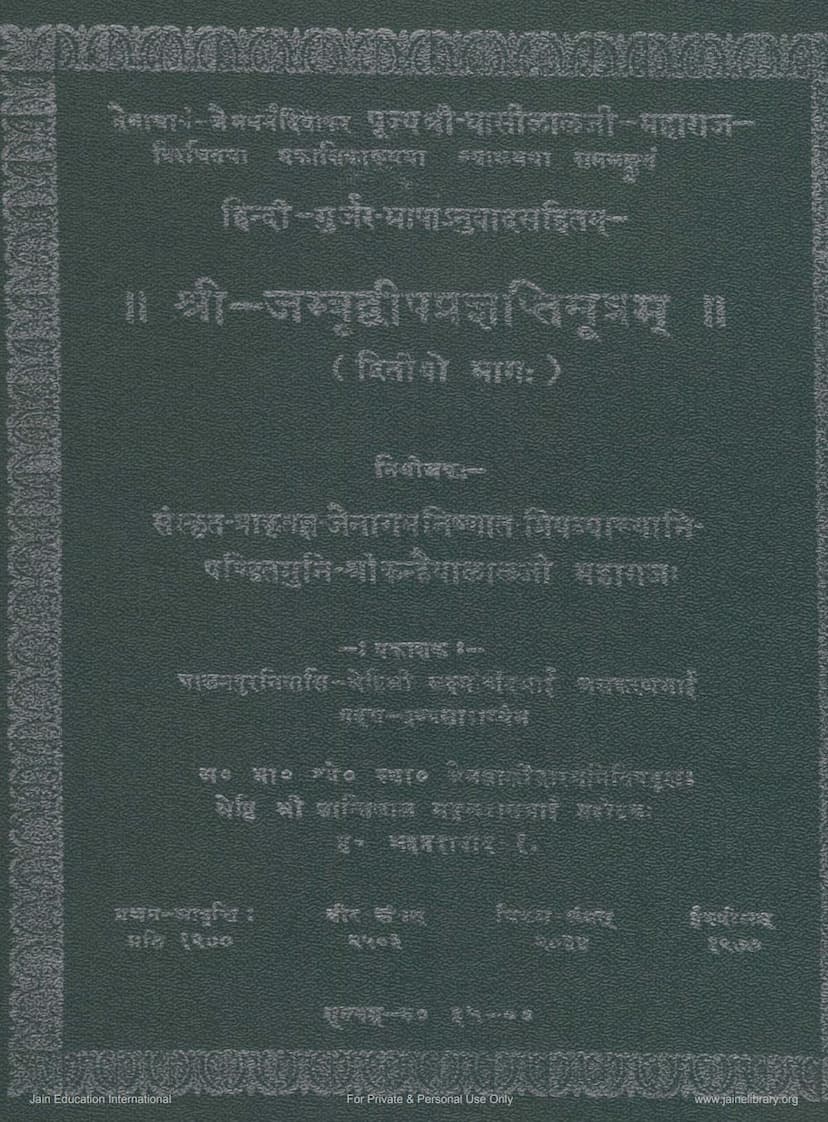Agam 18 Upang 07 Jambudveep Pragnapti Sutra Part 02 Sthanakvasi
Added to library: September 1, 2025

Summary
While I cannot access external websites or specific files like the provided catalog link, I can provide a comprehensive summary of the Jambudveep Prajnapti Sutra based on general knowledge of Jain Agamas and the context provided by the book title and author.
The Jambudveep Prajnapti Sutra, particularly Part 02 as edited or commented upon by Kanhaiyalal Maharaj and published by the Jain Shastroddhara Samiti Ahmedabad, is a foundational text in Jainism. It falls under the category of Upangas, which are subsidiary texts to the primary Angas. This particular text focuses on the Jambudveep, the central continent in the Jain cosmology.
Here's a breakdown of what you would typically find in such a text, especially in Part 02 which might delve into more specific details:
Core Subject Matter:
- Jambudveep Geography and Cosmology: The primary focus is on describing the Jambudveep, a continent shaped like a lotus. It details its dimensions, mountains (Vakshaskar Parvatas), rivers, land divisions (Varshas or Kshetras), cities, and the distribution of life within it, including humans, animals, and celestial beings.
- Mathematical and Astronomical Descriptions: Jain cosmology is known for its intricate and precise, albeit unique, mathematical and astronomical calculations. The sutra would likely contain detailed measurements of the continent, its features, distances, and possibly its relation to celestial bodies.
- Detailed Descriptions of Key Features:
- Mountains (Vakshaskar Parvatas): These are the major mountain ranges that divide the Jambudveep into various regions. The text would describe their names, locations, heights, and significance.
- Rivers: Major rivers originating from these mountains and flowing through the continent would be described.
- Regions (Varshas/Kshetras): The Jambudveep is divided into several regions like Bharat Kshetra, Mahavideh Kshetra, Hairavata, Hemavata, etc. Their characteristics, inhabitants, and geographical boundaries would be elaborated.
- Cities and Palaces: Descriptions of important cities, royal palaces, and the celestial residences of various gods and goddesses would be included.
- Lotuses and Lakes: The central lotus shape of the continent might lead to descriptions of significant lotus-shaped lakes or water bodies.
- Life and Beings: The sutra would describe the types of beings inhabiting these regions, their lifespans, characteristics, and the specific conditions of life in different zones, particularly the distinctions between karmabhumi (land of action) and akarmabhumi (land of no action).
- Religious Significance: While descriptive, the text also serves a religious purpose. The descriptions often relate to the life and journeys of Tirthankaras and other significant spiritual figures, their births, ascensions, and the environments associated with them.
- Commentary/Interpretation (Prakasha-khya Vyakhyana): The mention of "Prakasha-khya Vyakhyaya Samalankritam" by Ghasi Lal Ji Maharaj indicates that this edition includes a detailed commentary, making the complex sutra more accessible. Kanhaiyalal Maharaj's role as the "Niyojak" suggests his supervision and organization of this publication, likely involving the commentary and translation.
- Language and Translation: The title also mentions "Hindi-Gujjar-Bhasha-Anuvad-Sahit" indicating that the text includes translations into Hindi and Gujarati, making it accessible to a wider audience.
Potential Focus of Part 02:
Part 02 might specifically delve into:
- Further Geographical Details: More specific descriptions of the mountains, rivers, and their tributaries, possibly including details about their emergence and flow.
- Detailed descriptions of specific regions: Elaboration on the characteristics and inhabitants of regions like the Mahavideh Kshetra, Uttar Kuru, and Deva Kuru, which are often described in great detail in Jain texts.
- Celestial Beings and their Abodes: Descriptions of the residences and activities of gods (Devas) and goddesses (Devis) associated with different parts of the Jambudveep, their divine attributes, and their roles in the cosmology.
- Specific Events or Narratives: While the sutra is primarily descriptive, it might recount events related to Tirthankaras or other important figures that took place in the Jambudveep.
- Concluding Sections: This part might contain summaries, classifications, or appendices related to the overall description of the Jambudveep.
Author and Publisher Context:
- Kanhaiyalal Maharaj: As an author or compiler/editor, Kanhaiyalal Maharaj was likely a learned Jain scholar and monk, possibly associated with the Sthanakvasi tradition (as indicated by the publisher). His contribution would be in making the text accessible, potentially through translation, commentary, or scholarly arrangement.
- Jain Shastroddhara Samiti Ahmedabad: This publisher's name suggests an organization dedicated to the revival, preservation, and propagation of Jain scriptures. Their involvement indicates a scholarly and dedicated effort to bring this text to the public.
In essence, the Jambudveep Prajnapti Sutra Part 02 is an invaluable resource for understanding the Jain perspective on the structure of the universe, the geography of the central continent, and the beings that inhabit it, all presented within a sophisticated cosmological framework that is both descriptive and spiritually significant.